Anti-lock braking system ABS machine. Advantages and disadvantages
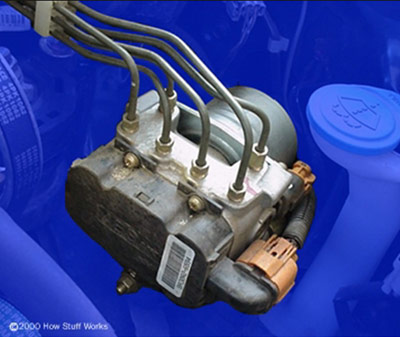
While learning to drive, most of us were taught to hit the brakes several times when the car starts to slip, because hitting the brakes will lock up the wheels and send the car out of control.
When ABS (anti-lock braking system) came out in the 1980s, it became necessary to forget everything you knew about braking. With this new system came new regulations, and for many people came the challenge of adapting to the anti-lock braking system.
Almost half of drivers do not know how to properly use ABS (anti-lock braking system)
How does car ABS work?
In recent years, there has been debate about the benefits of ABS. Some people argued that the system causes as many accidents as it prevents. But recently, research has shown that this technology is useful; drivers just need to know in which situations it works best.
So, before using ABS, drivers should know the effectiveness of the technology. Although the system is useful, it does not help stop the vehicle in all situations. Research has found that ABS works best to stop a vehicle (and therefore reduce accidents) on roads that are slick due to rain, snow or ice.
But the benefits of this technology in other circumstances are less clear. Research also shows that ABS has no benefit in reducing fatal crashes.
Understanding car anti-lock technology
During hard or emergency braking, cars with conventional braking systems require the driver to apply the brakes several times. In this case, some or all of the tires slip or skid.
Exactly how a car glides depends on the coefficient of friction between each tire and the road surface it comes into contact with. The car may slide forward, left or right, or may begin to rotate.
In any of these situations, the driver loses control of the vehicle.
Although there are different types of ABS, they all work in a similar way. The rotation speed of the wheels is checked. When the brakes are applied and the vehicle slows down, the electronic control unit determines when each wheel is likely to lose traction and lock up. The device reduces brake pressure to prevent wheel locking.
Because the wheels do not lock, the vehicle remains under control and the driver can avoid objects in front of it in the same way as other vehicles. This works on both dry and slippery roads, but is most useful on wet roads, as wheel locking is more likely in such conditions.
Training drivers to work with the car's anti-lock braking system
The most important task of the automobile industry is to teach drivers how to use the brake pedal in a car with ABS. For many drivers, slamming on the brakes several times is ingrained in their minds.
Keep your foot firmly on the brake pedal when using ABS. Also, don't take your foot off the pedal if it starts to throb, bounce or make noise, these are all normal.
Although most people don't take the time to carefully read their car's manual, it is necessary to do so. The manuals contain important information about how ABS works and how to use the system correctly.
Car ABS service
It is not enough to have a car with ABS and understand how to use this technology, you also need to know how to properly maintain the system.
The anti-lock braking system requires frequent maintenance due to the technology and parts of the system. The repair bill can reach a very significant amount if there is a problem with the system.
Experts say ABS needs fluid changes more often than a traditional brake system because brake fluid absorbs moisture, which can cause problems with a complex anti-lock system more easily than with a traditional one. Changing the fluid will get rid of the moisture.
Repair shops charge a fee to replace the fluid. A large sum will be required for mechanics to replace the hydraulic ABS modulator on a car that is several years old.
If you have a car with anti-lock braking system, it is not only important to know how to properly use the system, but also to understand that this technology, although effective, has its limitations.
Source: http://www.avtoshkolabars.ru/abs-antiblock-system-automobile/
How does abs work on a car - car portal
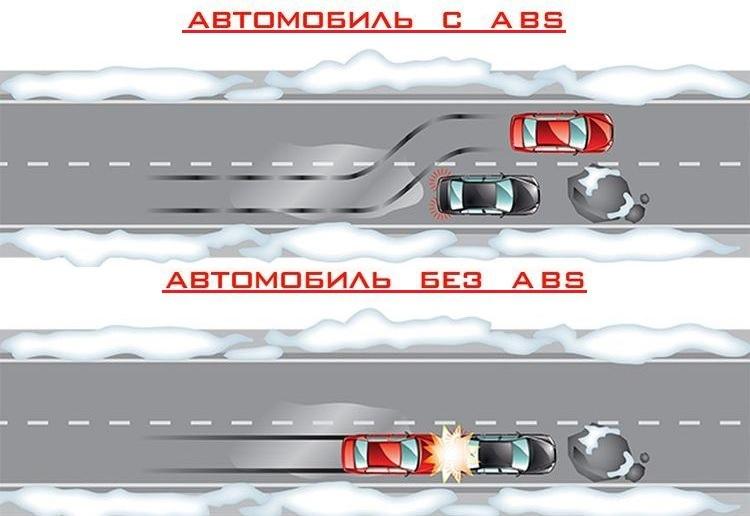
7 months ago
A modern car is equipped with a large number of electronic devices that ensure safe operation and comfortable driving. One such device is an anti-lock braking system (ABS) , or Anti-lock Brake System. ABS is activated to prevent wheel locking under all braking conditions.
ABS checks the speed of rotation of the vehicle's wheels when the brake pedal is depressed. If the rotation speed is lower or higher than the critical one, the system redirects the braking forces from the pedal, preventing the wheel from stopping rotating and the car skidding.
Thanks to this effect, directional stability is ensured, the car remains controllable, its speed decreases smoothly and gradually.
Electronic control unit (ECU). The ECU controls the valve body based on sensor readings. Speed control sensors, consisting of two parts.
A stationary coil with a core of magnetic material inside is built into the wheel hub (or drive axle gearbox). The ring gear is located on the wheel and rotates with it. The electromagnetic field changes due to the rotation of the wheel, and an electric current arises. The magnitude of the current is determined by the rotation speed.
Signals from the sensor to the control unit are generated based on the read induced current strength. Hydraulic unit. The valve body is located in the brake line near the main brake cylinder. The hydraulic unit consists of a hydraulic accumulator, a pump and solenoid valves. The hydraulic accumulator stores excess brake fluid.
The pump supplies fluid to the car’s cylinders or, conversely, if there is a threat of wheel blocking, it takes fluid.
Solenoid valves are divided into inlet and outlet valves. These valves regulate the pressure inside the brake cylinders.
ABS can operate in one of three modes: gradual decrease in pressure, increase in pressure, holding pressure at the same level. When the driver starts braking, the ABS, reading the sensor values, smoothly reduces the speed of the car. Before the wheel stops or slips, the speed control sensor sends a signal to the ECU. After receiving the signal, the unit turns on the release valve, blocking the movement of fluid into the brake cylinder, and the pump pumps it into the accumulator, eliminating the cause of the blockage. When the wheel locks up, the pressure is kept at the same level. At this moment, the ECU stops the flow of fluid into the cylinder(s); pressing the pedal does not cause blocking. If the wheel speed exceeds the permissible value, the ECU closes the outlet valve, turns on the pump that supplies fluid to the brake cylinder, and opens the inlet valve, causing the wheel to rotate slows down. All processes are repeated 4-10 times per second. If the wheels hit one on a dry surface and the other on a slippery one, the car with ABS will move in a straight line by regulating the pressure of each brake circuit. A car without ABS will “steer” towards the dry surface, and if the wheels are blocked, a sharp turn may occur with loss of control.
The operation of ABS is accompanied by feedback in the form of impulsive shocks from the brake pedal and a “crackling” sound that is heard from the modulator block.
If the system is working properly, the “ABS” indicator starts to light on the panel after turning on the ignition, and 2-3 seconds after starting the engine it stops lighting.
If the signal lights up while the engine is running, this is a reason to diagnose the system at a service station and, possibly, repair it.
It must be taken into account that the braking of a car with ABS must be continuous .
During the entire braking process, you must press the brake pedal with considerable force, and the system will provide a minimum and safe braking distance.
ABS provides a reduction in braking distances of up to 20% on dry roads.
The difference will be even more significant if you brake on ice, snow-covered roads, and wet asphalt. how ABS works on a car video
Disabling the vehicle's ABS system is not provided for . If you still remove the fuse from the block and turn off the system, on a modern car this will cause the rear wheels to lock, because the ABS redistributes the inter-axle braking forces, and other undesirable consequences. You will also be interested in the difference between an injector and a carburetor - link
Source: http://avtofil.ru/post/kak-rabotaet-abs-na-avtomobile-267004
What is ABS in a car? Operating principle of ABS
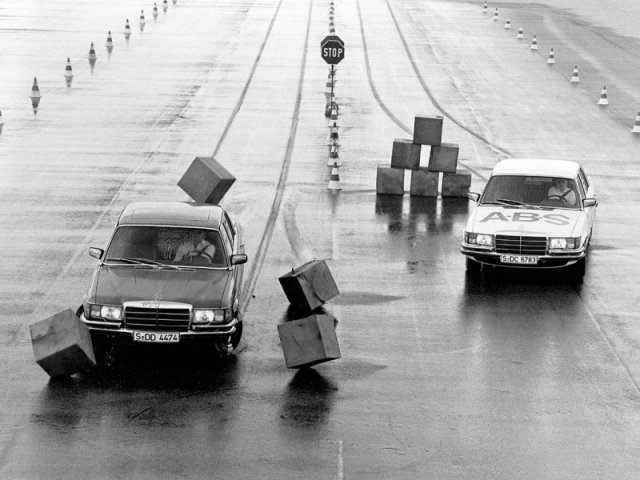
While driving a car, the driver must maintain concentration. An emergency situation may occur on the road at any time, which will require an immediate response.
A car ahead has suddenly braked, a wild animal has jumped out onto the road, or an inattentive pedestrian - in each of these cases you have to brake and try to avoid a collision, and the braking is often emergency.
And this threatens to block the wheels, which greatly increases the likelihood of an accident.
However, with the development of technology, it has become possible to solve many problems, and now almost all cars produced in the world (except ultra-budget ones) are equipped with a system that prevents wheel locking during braking. It's called ABS (Anti-lock Brake System). Today we will figure out how it works, what elements it consists of and how many varieties there are.
What is ABS in a car?
Thanks to ABS, when braking hard, the car listens to the steering wheel, since the wheels do not skid, but rotate. The person behind the wheel just needs to press the brake pedal as hard as he can, and the “smart” electronics will do the rest of the work itself.
If the car is not equipped with such a system, then during emergency braking the driver has no choice but to press the brake with short breaks so that the wheels do not lock. This technique is called “impulse braking.” But not all people are able to maintain a cool head in a moment of danger.
At the same time, pressing the brake pedal with all your strength will not only most likely lead to the wheels locking and, accordingly, to complete uncontrollability of the vehicle, but may also contribute to the car entering a skid. With this development of events, the chances of getting into an accident increase many times over. Even if you are very lucky and avoid skidding, the braking distance will increase significantly, which can lead to a collision or crash into a ditch.
To prevent the occurrence of the situations described above, the ABS contains special operating algorithms.
In particular, the system maintains increased brake fluid pressure so that the car's response to pressing the brake pedal is immediate.
In addition, ABS does not allow the calipers to compress all the way, and the wheels slip a little, continuing to rotate slowly, i.e. are not blocked. In other words, the system performs impulse braking for the driver.
ABS elements
The main components of ABS are:
- sensors that record the angular speed of the wheels;
- electronic control unit (ECU), where information received from sensors is analyzed;
- modulators that change the brake fluid pressure at the command of the ECU.
How does ABS work on a car?
The principle of operation of ABS on a car is based on commands issued by the electronic control unit. The sensor constantly records the angular speed of the wheel. If it drops sharply to almost zero, then the ECU gives the corresponding command to the modulator.
He reduces the pressure in the system using a valve equipped with an electric drive. Excess brake fluid ends up in the hydraulic accumulator, the wheel continues to rotate and does not lock.
As soon as the angular velocity begins to increase again and reaches a certain value, the electronic unit will give a command to resume braking.
The fluid from the accumulator will return, and the wheel will begin to slow down again. This algorithm will be repeated again and again as long as the brake pedal is pressed all the way, while the driver feels it pulsating and hears characteristic sounds, the source of which are the modulators. If the pedal is released, the ABS will return to “standby mode”.
ABS software algorithms are regularly updated, and the latest generation systems not only take into account the angular speed of the wheels, but also the slope of the road surface, the degree of adhesion of the wheels to the road, the operation of cruise control, etc. All this allows the system to work as efficiently as possible, increasing traffic safety .
Types of ABS
ABS can be implemented in different design schemes. On expensive cars, for example, the number of sensors is equal to the number of modulators and control channels, which makes the system extremely efficient. ABS installed on budget cars have a much simpler design: 2 sensors on the rear axle, 1 modulator and 1 ECU.
The most common ABS scheme has 4 sensors, 2 modulators (1 per axis) and 2 control channels. Also quite common is its modification with 4 sensors, 3 modulators and 3 ECUs (the front wheels are serviced together, and the rear wheels are serviced separately).
Source: http://avtgid.ru/chto-takoe-abs-v-avtomobile-princip-raboty.html
What is ABS and how does this system work?
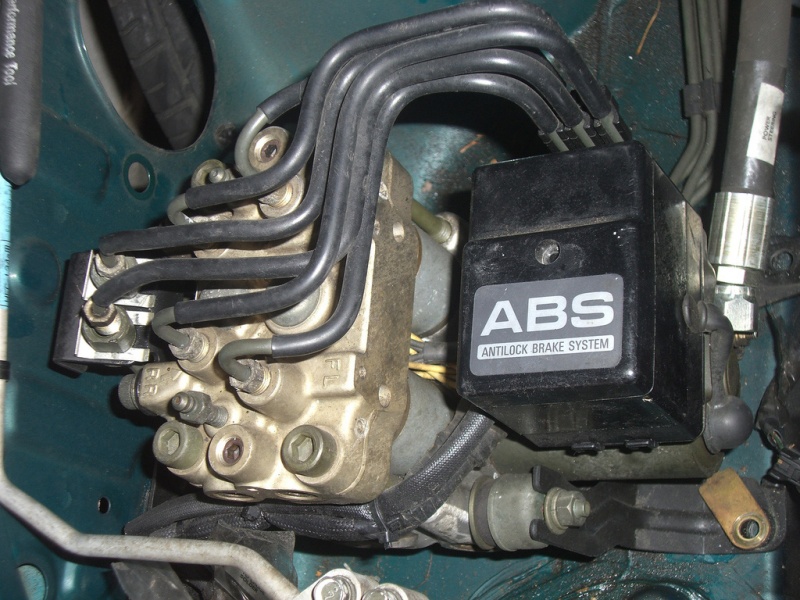
Good day to all! Andrey Kulpanov is in touch with you again on the pages of this blog.
Do you know how important the braking system is to ensure the safety of drivers and passengers while driving? Of course, who doesn’t know about this! And we have already raised the issue of the need to pump the system.
But not everyone can reliably explain what ABS is. But modern cars are increasingly equipped with this useful device. Therefore, today we will engage in educational education on this topic.
General description and principle of operation
Let's start with the fact that the abbreviation indicated in the title stands for anti-lock braking system. Today it has become almost synonymous with the more familiar concept of “brake system”.
Its action occurs precisely at the moment when the driver presses the brake pedal with his foot. The need for emergency braking can arise at any second - for example, a person jumps out onto the road or an open sewer manhole appears.
Sometimes you literally have to force your car to stop in a split second. How does the famous ABS work in this case?
If your car is not equipped with such a system, then it will slow down due to the fact that the pads are pressed against the brake disc or drum.
In this case, the position of the wheels does not allow you to change the trajectory to avoid the obstacle.
Unlike the classic design, ABS does not block the wheels themselves, which means that it remains possible to maneuver to the side. Agree that the chances of passing an obstacle in this case increase.
The ABS system maintains the necessary and effective traction of the car wheels with the road surface. And this already makes it possible to control the behavior of the car in certain situations. The wheels themselves are not blocked, but retain their mobility.
Then, when they are tightly clamped, any unevenness in the road surface poses an additional danger. Let's imagine emergency braking, in which the wheels are also blocked - in this case, the probability of skidding is very high.
This situation can easily turn your favorite car into a pile of iron.
What is included in the design
That's why designers were puzzled by how to prevent themselves from these troubles during sudden braking. And in the case of ABS, induction sensors work - they set the wheel speed, and each of them can be equipped with this useful option. It's time to talk about the basic elements that form the basis of the entire smart brake design. This:
- a control unit that receives signals and controls the operation of the sensors;
- deceleration and acceleration sensors, which are mounted in the wheel hubs;
- control valves related to the pressure module and located along the main line of the brake system.
As soon as braking begins, the ABS begins to calculate the rotation speed of each of the car wheels. If any of them spins slower than the others, it means it is close to blocking. And the valve forcibly reduces the braking force on it. It is restored when rotation accelerates relative to other wheels.
This process occurs imperceptibly, as already mentioned, and can be repeated dozens of times in one single second. The driver, if his car is equipped with the design described here, can understand this by a slight pulsation of the brake pedal itself. ABS can be of several varieties in terms of design:
- single-channel, affecting the entire system simultaneously;
- two-channel, which is designed on board;
- multi-channel - in this case, the braking force is calculated separately for each wheel, as on most modern cars, for example Ford Focus 2.
The last option is the most complex and therefore expensive, but the efficiency in this case is higher. This becomes especially noticeable when braking on a heavily icy road, after rain, or when the car pulls onto the side of the road.
Thanks to the diagnostic system, which is part of a modern ABS, it becomes possible to monitor emerging faults. If this continues, such a component or even the entire ABS is switched off, and then normal brakes begin to operate.
In such a situation, the possibility of a skid cannot be ruled out.
Finally
Is an anti-lock braking system really necessary for a modern car? The presence of such “smart” electronics additionally protects the driver from force majeure on the roads. It independently evaluates the sliding forces, blocks and releases the wheels at the required times.
These transitions will not even be noticeable to the driver, since everything is worked out automatically and takes a few fractions of a second. ABS becomes especially useful for novice drivers who find it difficult to comprehend the moment when the wheels lock.
It allows them to press the brake pedal without worrying about skidding, while still being able to make smooth maneuvers.
Meanwhile, even on old machines a similar principle of operation was known, only it was done manually, or rather “by hand”.
During emergency braking, it was necessary to release and press the brake pedal repeatedly to prevent skidding. However, this led to an increase in braking distance and was not always 100% effective.
The use of this principle in the ABS system and its automation eliminated the need for the driver to press the pedal multiple times.
This is where I propose to end the discussion of the features and advantages of this design. Read the blog in subsequent issues - there will be a lot of useful information about the car and its operation. And that's all for today!
Sincerely, blog author Andrey Kulpanov
Source: http://avto-kul.ru/poleznoe-ob-avtomobile/chto-takoe-abs.html
How does abs work on a car?
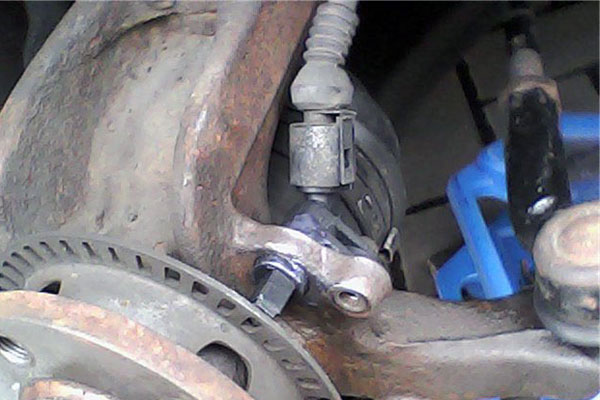
Home » Miscellaneous » How does ABS work on a car?
Modern cars are replete with various systems that help the driver safely drive the vehicle on any road. One of the first such “helpers” was the Anti-lock Brake System. Almost all leading auto companies have recently installed it not as an additional bonus, but as part of the basic package.
The principle of operation of ABS on a car is to not block the wheels at the request of the driver after pressing the brake pedal.
Instead, instant control and redistribution of braking force on the wheels is carried out.
Thanks to this algorithm, the car remains controllable, directional stability is ensured, while the vehicle safely reduces speed.
How did the mass introduction of ABS begin?
Engineers from automobile companies, performing safety-related tasks, have been developing ABS since the late 60s of the last century. Some of the first versions of these systems proved to be quite successful. In the next decade, such units were already introduced on production cars.
The leading company in this industry was the German Mercedes.
After experiments with mechanical sensors, which were installed only on one axis and transmitted information to the control unit about changes in pressure in the brake circuits, German engineers switched to contactless sensors.
This helped speed up the transfer of information to the logic block. The number of false alarms has also decreased, and wear has disappeared due to the elimination of rubbing surfaces.
The modern ABS system works on the same principle as was laid down in the first anti-lock braking systems developed.
It was the second generation of this unit, released in the late 70s, that began to be installed as a basic configuration on the prestigious cars of that time, the Mercedes-Benz 450 SEL.
Wheel operation in a car
The main task assigned to the ABS is to maintain maximum vehicle control during braking.
Since a locked wheel has significantly worse traction with the road surface, its braking forces will be much lower than that of a rotating wheel. The driver has no control over the non-rotating wheel at all.
The most acceptable option for moving a braking car would be straight-line movement, however, often the car goes into an uncontrolled trajectory.
The installed ABS unit contributes to the efficient operation of the wheels at a given time, balancing between blocking (without completely stopping rotation) and the highest level of grip on the road surface. An icy road and a dry road will provide different input parameters, but in both cases the system will strive to maintain maximum controllability.
It is believed that a well-adjusted anti-lock braking system is capable of driving a car at a higher level than a highly skilled driver in a car without ABS.
The anti-lock system calculates its work based on the wheel slip coefficient. It is found as the quotient of dividing the difference between the speed of the car and the peripheral speed of the wheels by the linear speed of the car. The indicator changes under different driving modes.
Intense acceleration gives a high peripheral speed to the wheel at a low linear speed of the machine, and sharp braking contributes to the opposite process. An example of one hundred percent slipping is two options: a blocked braking wheel and the process of slipping without moving, for example, in mud or a puddle.
In a modern brake system, anti-lock brakes manipulate electronic valves and a pump. The driver initiates braking by pressing the pedal, and if slippage does not occur, the anti-lock braking system is not involved in these actions.
The new machines are equipped with four-channel circuit layouts. Thus, control is carried out for each of the wheels. Each circuit is capable of operating in three modes:
- increased blood pressure;
- holding its meaning;
- decrease in pressure.
As the moment of wheel lock approaches, the pressure is maintained at the same level. At this time, the fluid supply from the brake cylinder is cut off and further pressing of the pedal does not lead to blocking.
If the calculated slip coefficient takes values of more than 20%, then the pressure is released through the pump.
Then slippage can, on the contrary, decrease by more than 15%, then the valves open to increase pressure when the pedal is pressed.
These modes are alternately turned on/off. The process most often stops after a significant reduction in speed to 5-15 km/h. The driver can hear the impact of the anti-lock braking system from the brake pedal. Even the greatest professional cannot repeat the speed of changing such cycles.
ABS elements
If a car hits one wheel on a dry surface and the other on a slippery surface, the vehicle with ABS will be kept straight by balancing the pressure for each circuit.
If a car gets onto such a road without this block, the car will move towards the dry road, and if the wheels suddenly lock, the situation will lead to a sharp turn with unpredictable consequences.
Source: http://racing-nn.ru/raznoe/kak-rabotaet-abs-na-avtomobile.html
Car abs, device and principle of operation
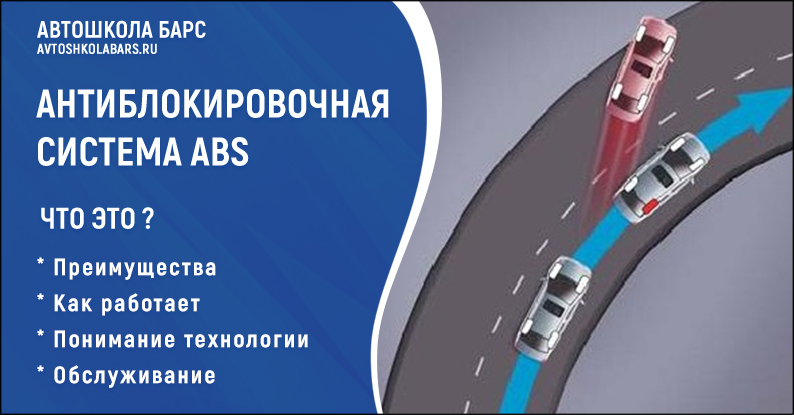
Today, most cars on the road are equipped with some type of anti-lock brake system. Let's see what this system consists of and how it works.
Operating principle of ABS
First, let's look at the basic principle of operation of the ABS system.
Since different manufacturers have their own versions of ABS, their specifications and parts may be called differently.
ABS is a four-wheel system that prevents wheel lock-up by automatically modulating the brake pressure on each wheel during emergency braking.
By preventing the wheels from locking, the system, firstly, allows the driver to continue steering the car, and secondly, it can reduce the braking distance.
During normal braking, ABS and non-ABS systems feel the same to the driver.
During emergency braking, when ABS is operating, you can feel a pulsation on the brake pedal, which is accompanied by vibration of the brake pedal and a characteristic sound.
Vehicle ABS device
Cars with ABS are equipped with a pedal drive with a dual braking system.
The main hydraulic brake system consists of:
- hydraulic control valve and electronic control unit.
- master cylinder
- brake pipes and hoses
- brake cylinders on each wheel.
The anti-lock braking system consists of the following components:
- hydraulic control unit
- ABS electronic unit
- front and rear anti-lock braking system sensors.
How does a car's ABS work?
The anti-lock braking system works as follows:
When you press the brake pedal, it presses on the fluid in the master cylinder and as a result, the fluid is squeezed out under pressure.
From the master brake cylinder, fluid flows into the ABS hydraulic control unit.
The hydraulic control unit has 4 outputs, each of which is connected by a tube to the brake cylinder on the wheel.
At each of these outputs of the ABS hydraulic unit there is a valve that is open in its original state.
Fluid under pressure is pushed out of the hydraulic control unit and through tubes and hoses enters the brake cylinders on each wheel.
Pressure is created in the brake cylinder on the wheel, and the fluid pushes out a piston, which is connected to the brake pads.
This causes the brake pads to press against the brake disc or drum. Because of this, a frictional force arises between the brake pads and the brake disc, and it slows down its rotation.
Accordingly, the wheel slows down its rotation.
In brake systems equipped with ABS, a toothed disc and sensor are attached to the hub of each wheel.
When the wheel rotates, the teeth of the disk pass near the sensor, which records this.
Data from the sensor is transmitted to the electronic control unit.
When braking very sharply, the wheel may lock and the sensor will notice this by the speed at which the wheel slows down.
As a result, the ABS electronic control unit, seeing that a wheel is blocked, sends a signal to the hydraulic control unit and closes the valve supplying brake fluid to this wheel.
As the brake fluid pressure on this wheel decreases, it stops braking and begins to rotate again.
As soon as the wheel begins to rotate, the valve on the hydraulic unit opens and the brake fluid pressure is again transferred to the brake system of that wheel.
The wheel starts to slow down again.
These actions are repeated very quickly and are manifested to the driver in the very characteristic sound and vibration of the brake pedal when pressed.
Thanks to this, when braking, the wheels do not lock and the car does not move, as is called skidding.
After all, when skidding, the car becomes uncontrollable and does not respond to steering control. ABS allows you to avoid this and preserves the driver’s ability to control the car.
For example, this will help you go around an obstacle without releasing the brake pedal. There is a misconception that cars equipped with ABS stop in a shorter distance than cars without ABS. In reality, this is often not true.
A car with ABS will, in most cases, travel a longer distance to come to a complete stop, but due to the fact that the driver can control the car, he will be able to avoid the obstacle, rather than just helplessly pressing the brake pedal and hoping that the car will stop in time.
The ABS system also has a positive effect on the tire tread condition. Indeed, in the absence of ABS and when the wheel is locked during braking, the tire will rub against the asphalt at only one point.
As a result of such braking, the tire can be severely worn out in one place. This does not happen when ABS is operating.
This is a description of the simplified operating principle of the ABS system.
In practice, the design of the brake system and ABS is much more complex. For example, the brake system of a modern car has at least two independent circuits.
This means that the front and rear wheels are controlled by separate pipes from the brake master cylinder.
This helps maintain the ability to brake the car, even if one of the brake system pipes becomes damaged.
Advice from a professional
ABS can vary significantly from one manufacturer to another.
In addition, this system can be very complex and require extensive experience and special tools for maintenance and repair. Therefore, an inexperienced driver should not attempt to repair the ABS on his own, but rather contact a specialist.
Source: http://prosedan.ru/abs-avtomobilya-ustrojstvo-i-princip-raboty
Operation of the anti-lock braking system
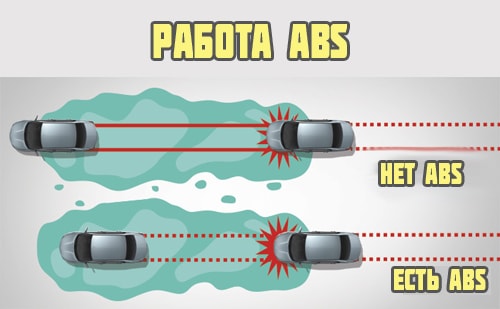
What is an ABS sensor and how does such a system work? How does it work and what does this abbreviation mean? All this will be discussed in this article, written exclusively for drivers and motorists.
ABS is an abbreviation that has been deciphered in various languages around the world. But the Germans, the British, and the Russians consider ABS a system that prevents the wheels from automatically locking during heavy braking.
Thanks to the system, the force exerted by the brake mechanisms is regulated.
And the main goal that the ABS system sets for itself is to provide the motorist with the ability to control the vehicle while maintaining stability and providing the most effective deceleration.
It is clear that when braking, especially sharply, a car whose wheels are blocked will roll over. To prevent this from happening, the ABS system was invented.
Video about safe braking:
Even before Hitler’s invasion of Europe, the idea of creating such a system was born in the minds of advanced engineers of that time. And they planned to use such a system not just anywhere, but in aviation itself. But the materials and technologies used at that time, unfortunately, did not make it possible to do this.
In 1964, Mercedes engineers took up this matter, rolling up their sleeves. Specialists from Bosch and Teldix helped them with this. And first of all, all the patents were collected, as well as reports for recent years, where the ABS system was mentioned in one way or another.
The research, which had begun so successfully, began to bear fruit. The engineers decided on a general scheme for creating a new system that could become a breakthrough in future technologies. The calculation of wheel speed was assigned to sensors, which were then only installed on the front axle.
The sensor sent these same measurements to the control unit, and if necessary, gave corrections to the control unit to adjust the pressure in the brake system, or rather, in any part of it. But everything went smoothly only on paper.
But as you know, all the brilliant discoveries of mankind were made first on paper, and only then transferred to the practical field of activity.
At first, the ABS system worked with errors in real situations. It responded to changes in wheel grip late and, in a word, was unreliable.
ABS system engineers achieved their first success in 1967, when they replaced mechanically based sensors equipped with wheels with non-contact options. The principle of operation in this case was used similar to electromagnetic induction. And the advantages here were clearly obvious: the ABS system did not trigger falsely, was resistant to mechanical stress and did not wear out for a long time.
Already in the mid-twentieth century, Mercedes introduced the first electronically controlled ABS system to the public, designed for buses, trucks and cars. New sensors transmitted signals to the control unit, which controlled the hydraulics, that is, the module located between the calipers and the brake cylinder.
Today, even the most modern ABS system repeats the principle of the very first model. Everything happens due to the work of sensors that monitor the speed of rotation of the wheels and provide information about this control unit. And it compares these values and sends appropriate commands to the electromagnetic components, in particular to the hydraulic module valve.
Mercedes was the first to introduce electronic ABS
The valves themselves are designed to regulate the pressure in the brake system. And this is done in a unique way - a pair for each of the circuits. When sudden and unexpected braking occurs, the components of the ABS system begin to move at a frequency of several tens of times per second and the vehicle slows down.
When the valves operate, drivers often hear them chirping, which means that the wheels are going through the locking/unlocking process. And the pressure in several circuits or in one of them instantly rises, and then is immediately released. As for the pads, they compress and release the disc accordingly, providing reliable braking.
This is how ABS works.
It is clear that the most important thing when driving a car is timely braking. And it is very difficult to keep the car in such conditions. But the ABS system helps cope with this perfectly.
In essence, the ABS system is a rather complex anti-lock braking system, which is an electronic-mechanical circuit that prevents the car from locking its wheels during heavy braking.
And the ABS system is especially needed when driving on roads where the vehicle’s wheels do not grip the road surface well enough. In other words, when driving on gravel, snow, snow or even ice.
An ideal safety system on the roads of Russia, where more than half of the months are winter.
Learning to drive a car with ABS does not cause any difficulties. You can drive at high speed and not be afraid of sudden braking, because the braking distance is noticeably reduced.
If you want to find out whether your car is equipped with such a system, just turn the ignition key. And then the inscription on the instrument panel will light up. The ABS system can also be determined by other parameters, including the overly sensitive brake pedal.
ABS icon on the instrument panel
What does it consist of?
A conventional ABS system consists of three components. An important one is the ABS unit, located in front and interacting with the braking system in a special way. Thanks to special metal tubes, the block is connected to the brakes.
In addition, the computer is part of the system. It processes the data received from the sensors and sends appropriate signals to the main unit.
And finally, speed sensors, without which none of the modern ABS systems could work.
Appearance of ABS with sensor
The main advantage of the ABS system
In practice, it has been proven through numerous tests that the ABS system allows shorter braking distances to be achieved. The car driver's ability to drive a vehicle increases several times while maintaining precise control.
In addition, the system makes it possible to carry out maneuvers even during moments of sudden braking. Combining the two factors described above, a car equipped with an ABS system gains a huge advantage over conventional vehicles.
Some experienced drivers are able to brake correctly even without an ABS system. They control the moment the wheels come off on their own, just like motorcyclists do. Thus, the force when stopping on the verge of blocking is weakened and the braking is not sharp, but intermittent.
But such an effect, obtained at considerable expense of effort and energy, is comparable only to single-channel ABS. And there is also, as you know, multi-channel ABS, designed to control the braking force on each wheel separately. This type of ABS allows you not only to brake effectively, but also to stabilize the behavior of the vehicle in difficult conditions.
For example, when driving on a snowy, icy road, when the adhesion of the wheels to the road surface is uneven.
In any case, for a novice driver, even single-channel ABS will be an excellent assistant. He will learn to brake calmly, without fear of the consequences. He will simply need to apply maximum force to the brake pedal or handle, while maintaining the ability to maneuver.
The operation of the ABS system in some cases, as mentioned above, leads to an increase in braking distance. This is very important, for example, if you drive on winter roads on summer tires. In addition, on loose surfaces such as deep snow or gravel, wheels that are locked when braking burrow deep into the surface, which provides additional deceleration.
Interestingly, some cars are equipped with an ABS system that automatically turns off. In fact, it is very convenient and effective.
And even some ABS models are equipped with a special braking algorithm, which allows you to achieve effective deceleration without loss of control. The same thing happens with complete blocking.
As for the surface type, it can even be set manually by the driver by connecting special sensors.
Break Assist technology
This technology, used for ABS systems, appeared back in 1994 on the then and today popular German car Audi. Soon, having learned all the advantages of the technology, other companies followed Audi: Volkswagen, Mercedes, Infiniti, etc.
Just as ABS works on a car, Brake Assist technology allows the driver to brake effectively.
According to statistics, most drivers in an emergency do not press the brake completely or, on the contrary, release the brake pedal.
And because of this, the braking distance turns out to be noticeably longer than it could be. Break Assist technology is precisely designed to automate this process.
Video about the disadvantages of ABS:
And finally. The ABS system is a smart robot that does almost everything related to the car's braking system instead of a person. And in some cases it does it even better than a human.
Source: http://365cars.ru/soveti/kak-rabotaet-abs.html
What is ABS in a car - how it works, how can it help? + video
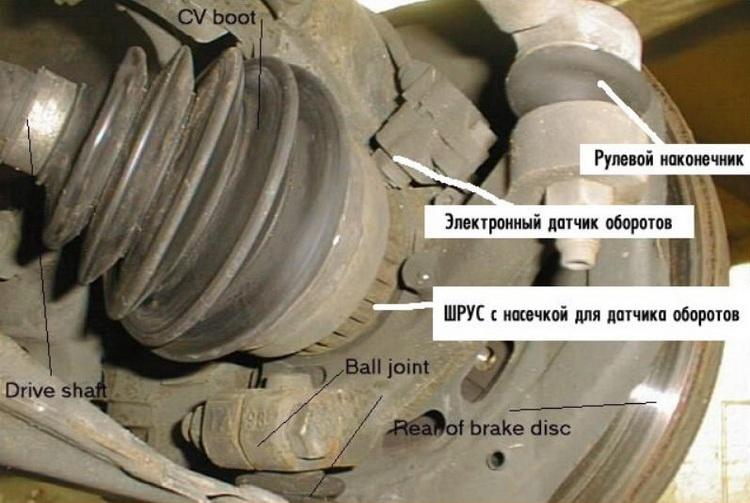
We will try to figure out what ABS is in a car in the next 5 minutes while you read our article.
It would seem to be a shame for a modern motorist not to know such a concept, but our task is precisely to explain what is awkward to ask about in our own environment.
The new-fangled expression “anti-lock braking system” is synonymous with a modern braking device that allows you to maneuver with the brake pedal pressed. What's the gain?
ABS system in a car - to be or not to be?
Let's look at how the ABS system works in a car when the brake pedal is pressed, and compare it with a conventional system.
When we see an obstacle in front of us, or rather, when it arises unexpectedly, and we are forced to suddenly try to stop, then the main difference between the anti-lock braking system and the conventional one awaits us.
After all, during a normal smooth stop, we will not feel the difference; the full effect will be revealed in an emergency situation. So, we nervously press the brake accelerator with maximum force, and what happens at this moment?
In the usual case (without ABS), the car begins to stop due to the fact that the wheels are tightly clamped by the corresponding mechanisms and stop spinning, but the axle on which they are located also becomes not mobile, but is locked.
If at this moment you still need to move to the side at least a little in order to avoid a collision or move it along a tangential trajectory, then nothing will come of it. You will move along the trajectory determined by the position of the wheels.
What is ABS in a car and what do we gain?
If we have an anti-lock braking system, we benefit not only from the presence of moving wheels when the brake pedal is depressed.
As experienced motorists know, when the wheels are blocked, any unevenness in the road, its slope, heterogeneity of coverage under different wheels, and even differences in tread patterns become critical.
What's the matter? In all cases, you are in danger of a terrible skid! And it is no longer known what would be better, crashing or reaping the fruits of the uncontrolled behavior of a pile of iron weighing more than a ton.
The ABS system allows the wheels to maintain traction at the proper level and control the behavior of the car depending on the situation.
This happens thanks to induction sensors that determine the wheel speed, and they also give the command to increase or decrease it. Hall sensors are also successfully used in ABS.
In modern foreign cars, each wheel is equipped with a sensor, although previously the device was single-channel, and one analysis algorithm and action commands were applied to all wheels.
Is it possible to do without the ABS system?
As you can see, the ABS braking system is smart enough to manage our braking force optimally, because the electronics are responsible for this.
Hence, by the way, the braking distance is shorter, thanks to the laws of physics, the system calculates the optimal dose of sliding and resting friction forces, provides blocking in time and releases it in time so that you don’t even feel these transitions, but simply hold the brake pedal almost to the floor.
But these are all the machinations of technological progress, but what about those who have an older car and have not yet been equipped with such “intelligence”?
Previously, they coped something like this: they pressed on the brake, then released it, pulled the steering wheel in the direction of avoiding the obstacle, pressed the pedal again, etc., creating an anti-blocking effect, roughly speaking, manually.
But this is fraught with the same drifts, and therefore not all drivers cope successfully with emergency situations. And braking efficiency also suffered, the braking distance was even longer and the trajectory was not always adequate.
So there was a chance to avoid an accident, but it was significantly less than with ABS on a modern car.
Source: https://carnovato.ru/sistema-abs-avtomobilya/







